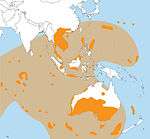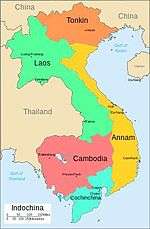Australasian strewnfield

The Australasian strewnfield is the youngest and largest of the tektite strewnfields, with recent estimates suggesting it may cover 10%-30% of the Earth's surface.[1]
Details

The c. 790,000-year-old strewnfield (Schneider, 1992)[2][3] includes most of Southeast Asia (Thailand, Laos, Vietnam, Cambodia, and Southern China). The material from the impact stretches across the ocean to include the Philippines, Indonesia, Malaysia, and Java. It also reaches far west out into the Indian Ocean, and south to Australia and Tasmania. Since the 1960s, it has been accepted that the strewn field included Hainan in southern China to Australia or about 10% of the Earth's surface.[1] This was later extended by finds in Africa and Tasmania to 20%. Recent additional finds in northern Tibet and Guangxi increased the strewnfield to about 30% of the Earth's surface, or almost 150 million km2.[1]
Impact crater
The Earth Impact Database lists about 25 known craters less than a million years old, almost all of which are less than 2 km in diameter. The notable exception is the 14-km Zhamanshin crater in Kazakhstan which at one time (Glass, 1979) was proposed as the source of the Australasian strewn field.[4]
However, due to the enormous size of the Australasian strewn field, the impact crater has been conjectured to be significantly larger than the known ones.[1][5][6] Schmidt and Wasson (1993) suggested it could be a 14–17 km crater beneath the Mekong Valley,[7] Schnetzler (1996) considered a 35–40 km structure in southern Laos,[8] Hartung and Koeberl (1994) proposed the elongated 100 km x 35 km Tonlé Sap lake in Cambodia (visible in the map at the side),[6] while Glass (1994) estimated it to be between 32 and 114 km in diameter in Cambodia.[5] Glass (1999) also suggested southern Laos or an adjacent area as a possible source.[9] More recently, Lee and Wei (2000) gave its size as 90 to 116 km[10] and P. Ma et al. (2001) using beryllium-10 postulated the crater as between southern Laos and Hainan, possibly within the Gulf of Tonkin.[11][12]
Alternatively, Wasson, who also found layered tektites in central Thailand,[13] conjectured it could have been a multiple impact event spread out over the region,[14] though it seems this scenario also raises substantial problems.[6]
The Wilkes Land crater in Antarctica has also been proposed as a possible source.[15]
It has been suggested that the impact may have triggered the Brunhes–Matuyama reversal.[16][17]
Homo erectus

Archeological artifacts found with these tektites in Baise, Guangxi in southern China indicates that a Homo erectus population was living in the area during and after the impact.[18][19][20][21]
Stone tools have been found within the debris field along with a charcoal layer likely caused by fires from the impact. It has been suggested that the subsequent local deforestation after the fires allowed this population easier access to stones useful for tool-making.[18]
See also
References
- 1 2 3 4 Povenmire H., Liu W. and Xianlin I. (1999) "Australasian tektites found in Guangxi Province, China," 30th Annual Lunar and Planetary Science Conference, Houston, March 1999.
- ↑ Schneider D.A., Kent D.V. & Mello G.A. 1992. A detailed chronology of the Australasian impact event, the Brunhes-Matuyama geomagnetic polarity reversal, and global climatic change. Earth and Planetary Science Letters 111, 395-405.
- ↑ Pillans, B., Simmonds, P., et al (2012) "Tektites, minitektites and microtektites from the Kalgoorlie region, Western Australia", Australian Regolith and Clays Conference, Mildura, 7–10 February 2012.
- ↑ B.P. Glass (1979), Zhamanshin crater, a possible source of Australasian tektites? Geology, July 1979, v. 7, p. 351-353
- 1 2 Glass B.P. and Pizzuto J.E. (1994) "Geographic variation in Australasian microtektite concentrations: Implications concerning the location and size of the source crater," J of Geophysical Research, vol 99, no E9, 19075-19081, Sept 1994.
- 1 2 3 Hartung J. and Koberl C. (1994) "In search of the Australasian tektite source crater: the Tonle sap hypothesis", Meteoritics.
- ↑ Schmidt G. and Wasson J. (July 1993) "Masses of the impactor, the Australasian tektites, and size estimates of the main source crater", Meteoritics, vol 28 no .3, 430
- ↑ Schnetzler C. C. and Mchone J.F. (1996) "Source of Australasian tektites: Investigating possible impact sites in Laos", Meteoritics and Planetary Science, Vol. 31, p. 73-76
- ↑ Glass B.P. (1999) "Muong Nong-type Australasian tektites: implications regarding the parent material and source area," Ninth Annual V.B.m Goldschmidt Conference, Massachusetts, August 1999.
- ↑ Lee M.Y. and Wei K.Y. (2000) "Australasian microtektites in the South China Sea and West Philippine Sae: implications for age, size and location of the impact crater", Meteoritics and Planetary Science, vol 35, no. 6, 1151-1155.
- ↑ P. Ma et al (2001)10Be in Muong Nong-Type Australasian Tektites: Constraints on the Location of the Source Crater, Lunar and Planetary Science XXXII (2001)
- ↑ Whymark, A. (2013) Review Of The Australasian Tektite Source Crater Location And Candidate Structure In The Song Hong-Yinggehai Basin, Gulf Of Tonkin, 44th Lunar and Planetary Science Conference (2013)
- ↑ Wasson et al (1995) Field recovery of layered tektites in northeast Thailand. Evidence of a large-scale melt sheet. J. Geophysics. Res. 100, 14383-14390.
- ↑ Wasson, J.T. (1991) Layered tektites: A multiple impact origin for the Australasian tektites. Earth Planet. Sci. Lett. 102, 95-105
- ↑ Schmidt, RA (1962). "Australites and Antarctica". Science. 138 (3538): 443–444. Bibcode:1962Sci...138..443S. doi:10.1126/science.138.3538.443. PMID 17794921. Abstract.
- ↑ Glass B.P. & Heezen B.C. 1967. Tektites and geomagnetic reversals. Scientific American 217, 32-38.
- ↑ Glass, B. P., Swincki, M. B., & Zwart, P. A. (1979). "Australasian, Ivory Coast and North American tektite strewnfields - Size, mass and correlation with geomagnetic reversals and other earth events" Lunar and Planetary Science Conference, 10th, Houston, Tex., March 19–23, 1979, p. 2535-2545.
- 1 2 "Handaxe and tektites in Bose, China". Archived from the original on 2011-08-30. Retrieved 2012-04-23.
- ↑ Paine M. (2001) "Source of the Australasian Tektites?" Meteorite, Feb 2001.
- ↑ "SCI/TECH | Asia's oldest axe tools discovered". BBC News. 2000-03-03. Retrieved 2015-10-20.
- ↑ "Early Dispersals of Homo from Africa". Annual Review of Anthropology. Annualreviews.org. 33: 271–296. October 2004. doi:10.1146/annurev.anthro.33.070203.144024. Retrieved 2015-10-20.